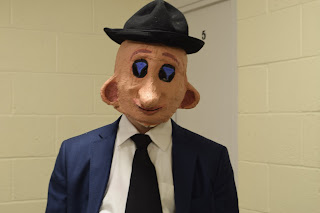Storyboard Artist
[sorry for the unexciting presentation :( ]
A storyboard artist's job is to illustrate scenes of the film in a graphic format, to make the narrative clearer visually for the filmmakers, serving as a prominent visual aid.
The attributes a storyboard must have is to have a good understanding of film language, including compostion and layout for scene continuity, as well as the ability to be to tell a story through illustrations.
And as an obvious attribute, they must have exceptional drawing skills (and in the case of animation, digital editing skills).
Storyboard artists work alongside the director of the project, as well as the screenwriter and occasionally the producer. The storyboards are created as a way to visually piece together the character compostions, camera movements, and several vital lines of dialogue. These help to realise how each scene plays out, or at least the more prominent segments of the scenes, and are usually rough drafts to first map out how each scene will play out. If the director or scriptwriter isn't happy with certain scenes, another storyboard for the scene is drafted, and in some occasions several storyboards at once to map out various outcomes on how a scene plays out.
Storyboard panels are drawn out much like comic-strip panels, drawing up the action that may be difficult to coordinate without visual aid. As well as this, the storyboard panels also help plan certain shots and help maintain continuity between scenes.
Since the purpose of storyboard artists is to showcase the action of characters, camera movement and so on, storyboards are not nessesarily used for every genre of film, though can be employed if some scenes are difficult to map out. Genres such as period movies and dramas do not nessesarily use storyboards as those types of films are mainly driven through dialogue as opposed to action.
Storyboards are very prominent in the following genres:
-Action
-Sci-fi/Fantasy
-Horror
-Comedy (for certain situations that require a lot of complex movement)
-Animation
Though this doesn't comply to ALL genres that follow a more dialogue-driven narrative, as storyboards are also used to plan out certain camera shots
A great example of a storyboard artist is Kurt Hartfelder, who worked on the Batman: The Animated Series.
He depicts the storyboard very much like a comic book (which makes sense given the subject matter) and as a result fantastically executes the actions and camera movements of each scene; an excellent example of this is the opening for each episode.
http://kurthartfelder.blogspot.co.uk/2010/08/batman-animated-series-storyboards.html
Another example of a very notable storyboard artist is Oscar Wright, brother of director
Edgar Wright, whose most know for directing the "Three Flavour Cornetto Trilogy".
While only drawing up storyboards for Shaun of The Dead and Hot Fuzz, Oscar Wright was also the concept artist and designer of the main titles.
Oscar Wright's panels is very much in graphic style format, albeit less bold as Hartfelder's work, possibly due to the panels being roughs, in case the scenes get rewritten or redrafted. But despite this, the illustrations are bold and clear enough to understand the flow of the characters, actions and camera movements/compositions.
Storyboards are very important if the director wants to maintain continuity between scenes, especially if the scenes have several complexities to deal with at once, such as the compostion of the characters and camera movements. Though visual, panels also include notes alongside to verbal dictate how, for example, the camera moves and transitions between scenes.As a visual aid, the director can also make choices in how to shoot and compose scenes much easier, and try out several scenerios in order to get the scene just how the director wants.
Films of lesser quality, may be quite evident in how storyboards were not applied, as well as overal poor direction, thus leading to not only a badly pieced together product, but also a film that has lumbering and dull, uninspired scenes.


















